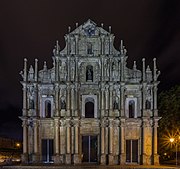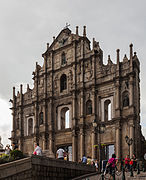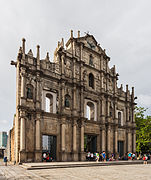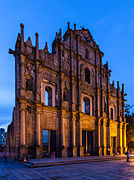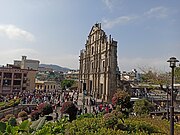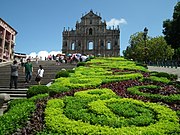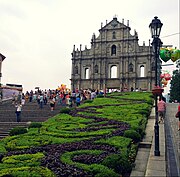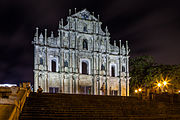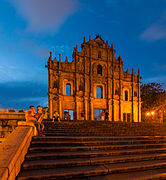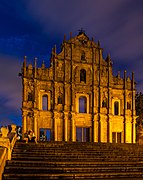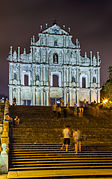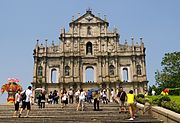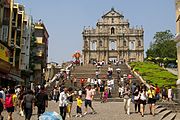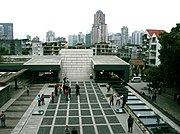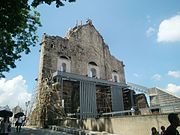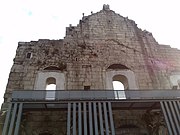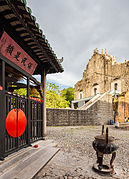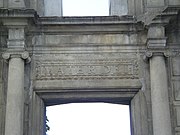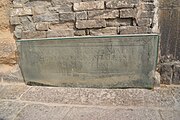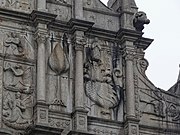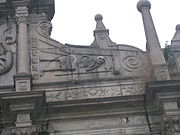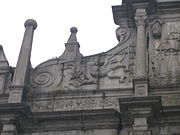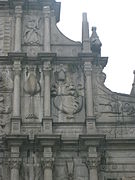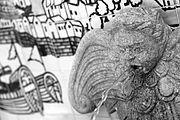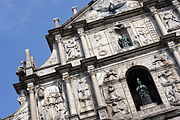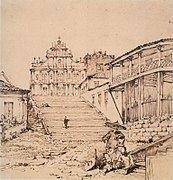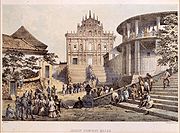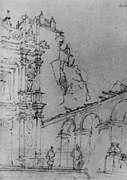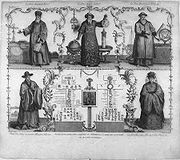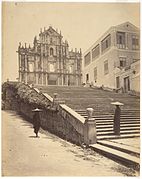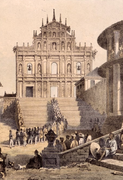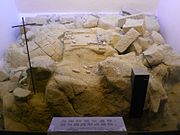Ruins of Saint Paul's
| Ruins of Saint Paul's | |
|---|---|
Catholic Church | |
| Restored | 1995 |
| Architectural style(s) | Baroque |
| Governing body | Macau Cultural Bureau |
| Website | http://www.wh.mo/cn/site/detail/18 |
| Ruins of Saint Paul's | |
|---|---|
| Chinese name | |
Hanyu Pinyin | Dàsānbā Páifāng |
| Yue: Cantonese | |
| Yale Romanization | daaih sāam bā pàaihfōng |
| Jyutping | daai6 saam1 baa1 paai4 fong1 |
The Ruins of Saint Paul's (
History
Built from 1602 to 1640

The ruins now consist of the stone frontispiece.[2]: 121 The façade sits on a small hill, with 68 stone steps leading up to it.
The façade is shaped like a
The Japanese Christian craftsmen who worked on St. Paul's were converted by Jesuits and expelled from Japan in 1587 when Toyotomi Hideyoshi banned Christianity.[2]: 122
The remains of around 250 Korean and Japanese slaves from the Portuguese slave trade are buried near the church.[3]
Conservation
Resisting calls for the dangerously leaning structure to be demolished, from 1990 to 1995, the ruins were excavated under the auspices of the Instituto Cultural de Macau to study its historic past.[
The ruins were restored by the Macanese government into a museum, and the façade is now buttressed with concrete and steel in a way which preserves the aesthetic integrity of the façade.[citation needed] There was once a steel stairway that allowed tourists to climb up to the top of the façade from the rear, but due to concerns for the preservation of the church, tourists are no longer allowed to climb up.
Gallery
-
The emblem of the Jesuit Order on the Ruins of the St. Paul.
-
This is the entry of Cathedral of Saint Paul in Macau. "MATER DEI" is engraved on the front door, which means "Mother of God".
-
The foundation stone, laid in 1602, under the front wall (i.e. the Archway) of St. Paul's Church. The inscription "VIRGINI MAGNÆ MATRI CIVITAS MACAENSIS LIBENS POSVIT·AN·1602", which can be interpreted as: "The City of Macau built this Church in honour of the Great Virgin Mother in the year 1602".
-
Detail from the Saint Paul church ruins in Macau. The carvings include Jesuit images with Oriental themes, such as The Blessed Virgin Mary stepping on a seven-headed hydra, described in Chinese characters as 'Holy Mother tramples the heads of the dragon'.
-
St. Paul's College and Church before the fire in 1834. It can be seen that most of the buildings of the College and Church, including the bell tower, still exist, painted by George Chinnery.
-
Ruins of the main altar of the church after the fire. Painted by Chanary in 1835.
-
The St. Paul's archway in 1870, photographed by John Thomson.
-
The façade of St. Paul's Church by Wilhelm Heine, 1854
-
After the Great Fire of 1835, the cloister next to the church survived and the bell tower next to it was badly damaged.
-
Some scholars who passed through the College:Adam Schall (center), Ferdinand Verbiest (right); below Xu Guangqi and his granddaughter Candide Hiu
-
Jesuit missionary Ferdinand Verbiest. This is an enlargement of a part of the image that is to the left.
-
1869
-
1 October 1908
-
1854
-
The ruins of the main altar no longer exist and are now the Museum of Sacred Art and Crypt
-
Entrance to the museum
-
The original Inner Harbor view on the St. Paul's archway is obscured by modern buildings, and the statue of Matteo Ricci is on the lower right.
-
Looking at the ruins of St. Paul's Cathedral, St. Paul’s archway, stone steps and inner harbor from the Fortress in 1955
See also
References
 Media related to Ruins of St. Paul's at Wikimedia Commons
Media related to Ruins of St. Paul's at Wikimedia Commons- 192183185 Ruins of Saint Paul's on OpenStreetMap
- ^ a b "China". The Morning Post. British Newspaper Archive. 8 July 1835. Retrieved 16 July 2014.
- ^ ISBN 978-1-5179-0031-1.
- ^ KBS 역사추리 – 임진왜란은 노예전쟁이었다 2부 / KBS 19960913 방송, 1996-09-13, event occurs at 12:41, retrieved 2024-02-09





